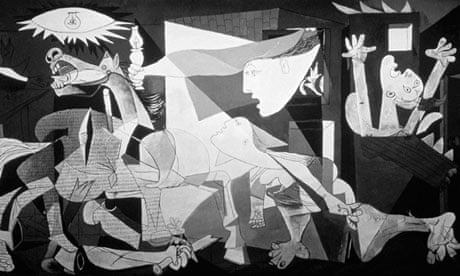Pablo Picasso painted his most famous picture in black and white. Guernica denounces a bloody attack without ever using the red of blood. Picasso's anti-war masterpiece, protesting the bombing of a Basque town in the Spanish civil war, is a monochrome epic of blacks, whites and shades of grey. Why did he paint it like this?
At first sight, it may seem easy to explain. Some of the black-on-white lines in Guernica look like newsprint. When Picasso painted his visual cry of anguish, the bombing of Guernica by Hitler's airforce in support of Spanish fascists on 26 April 1937 was news. Painting his instant response that same year in Paris, he was reporting current events. The newspaper grey of his painting (in an era before colour newsprint) stressed its immediacy.
But there is far more to it, as a current exhibition at the Guggenheim Museum in New York makes clear. Picasso Black and White explores this artist's lifelong interest in stripping colour out of painting: his attempt to replace sensual pleasure with intellectual design.
Design versus colour is an artistic debate that goes back to the Renaissance. Art in Renaissance Florence – as I argue in my book The Lost Battles – was all about "design". It was based on drawing, and ideas. That was why Michelangelo sneered that his Venetian rival Titian would be quite good if he learned to draw – those Venetian painters, in Michelangelo's eyes, were brainless colourists, purveyors of gaudy eye-candy.
In the 20th century, Picasso played Michelangelo to Matisse's Titian. The wild colours of Matisse express everything in imaginative hues. Matisse is a god of colour. Picasso, by contrast, argued that colour is secondary in painting. For him, the structure of things is bone and shadow.
Picasso's cubist revolution before the first world war was a rejection of surfaces and their colours, a search for what lies beneath the conventional, pretty pictures of art. In the so-called "analytical" phase of cubism, he almost abolished colour. His most profound paintings from this period lead the eye into a brown and black labyrinth, where reality must be relearned from the inside out. That radical search for the hidden structure of the world is at the heart of Picasso's enterprise.
In the 1930s, he returned to the monochrome mentality of cubism. This time, he was searching not for the bare bones of cognition but the hidden truth of the psyche. The prints in his Vollard Suite invent a new visual language of lines and shade to evoke the deepest urges and terrors. This same monochrome mythology spills into paintings of the 1930s, including Guernica.
Guernica is in black and white because it is digging into the truth behind pictures. A picture, in colours, is to be looked at. Picasso in Guernica does not want us to passively look, but to imagine this terrible moment from the inside. Colours let us off lightly; black and white forces us to think. Picasso is nothing if not a thinker.

Comments (…)
Sign in or create your Guardian account to join the discussion